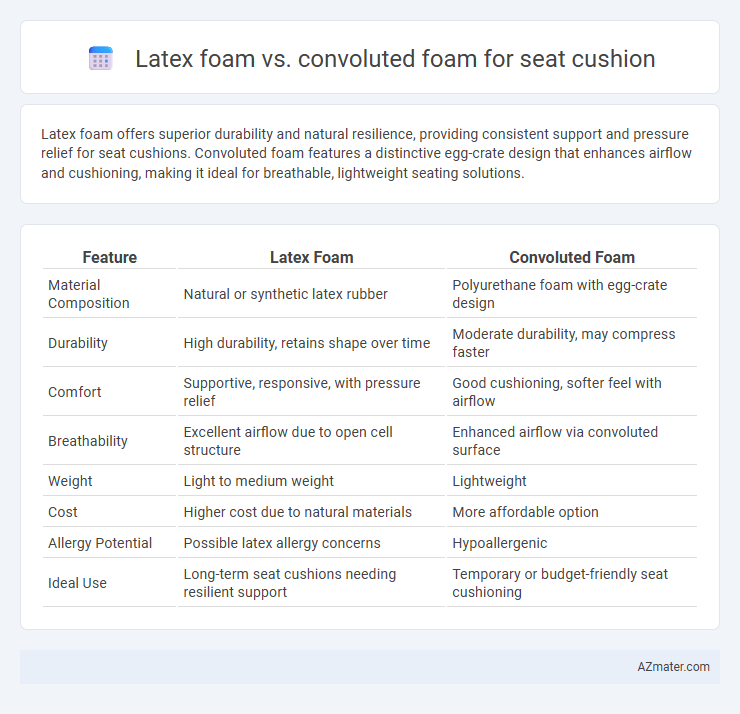Latex foam offers superior durability and natural resilience, providing consistent support and pressure relief for seat cushions. Convoluted foam features a distinctive egg-crate design that enhances airflow and cushioning, making it ideal for breathable, lightweight seating solutions.
Table of Comparison
| Feature | Latex Foam | Convoluted Foam |
|---|---|---|
| Material Composition | Natural or synthetic latex rubber | Polyurethane foam with egg-crate design |
| Durability | High durability, retains shape over time | Moderate durability, may compress faster |
| Comfort | Supportive, responsive, with pressure relief | Good cushioning, softer feel with airflow |
| Breathability | Excellent airflow due to open cell structure | Enhanced airflow via convoluted surface |
| Weight | Light to medium weight | Lightweight |
| Cost | Higher cost due to natural materials | More affordable option |
| Allergy Potential | Possible latex allergy concerns | Hypoallergenic |
| Ideal Use | Long-term seat cushions needing resilient support | Temporary or budget-friendly seat cushioning |
Understanding Latex Foam: Composition and Benefits
Latex foam, derived from natural or synthetic rubber, offers exceptional durability and resilience, providing consistent support crucial for seat cushions. Its open-cell structure enhances breathability, reducing heat buildup and promoting comfort during extended seating. Additionally, latex foam's hypoallergenic and antimicrobial properties make it an ideal choice for users seeking a healthy and supportive cushion material.
What Is Convoluted Foam? Structure and Features
Convoluted foam, often known as egg crate foam, features a unique surface pattern of peaks and valleys that enhances airflow and provides contouring support for seat cushions. Its distinctive structure distributes weight evenly, reducing pressure points and increasing comfort during prolonged sitting. The open-cell design improves breathability, making convoluted foam an ideal choice for ergonomic seating applications.
Comfort and Support: Comparing Seating Experience
Latex foam provides consistent support and adapts to body contours, offering pressure relief and durability for long-term comfort in seat cushions. Convoluted foam, designed with peaks and valleys, enhances airflow and reduces heat buildup but may offer less uniform support compared to latex. The choice between latex foam and convoluted foam depends on balancing individualized cushioning with ventilation needs for optimal seating comfort and support.
Durability and Longevity: Which Lasts Longer?
Latex foam offers superior durability and longevity compared to convoluted foam, maintaining its shape and support for up to 10-12 years under regular use due to its natural resilience and elastic properties. Convoluted foam, while providing good initial comfort and breathability, tends to compress and degrade faster, typically lasting around 3-5 years before losing significant cushioning performance. For seat cushions requiring long-term durability and consistent support, latex foam is the preferred choice.
Pressure Relief and Body Conformance
Latex foam offers superior pressure relief and excellent body conformance due to its natural elasticity and responsiveness, which evenly distributes weight and reduces pressure points. Convoluted foam, characterized by its egg-crate design, enhances air circulation and provides moderate pressure relief by contouring to body contours, but it generally offers less support and durability compared to latex. When selecting a seat cushion, latex foam is preferred for long-term comfort and optimal pressure distribution, while convoluted foam suits temporary use with moderate pressure mitigation.
Breathability and Temperature Regulation
Latex foam offers superior breathability due to its open-cell structure and natural ventilation properties, which efficiently dissipate heat and moisture, promoting a cooler seating experience. Convoluted foam, with its egg-crate design, enhances airflow around the cushion surface but generally retains more heat compared to latex. For optimal temperature regulation and comfort in seat cushions, latex foam is preferred for its combination of breathability and moisture-wicking capabilities.
Allergy-Friendly Options: Latex vs Convoluted Foam
Latex foam is naturally hypoallergenic, resistant to dust mites, mold, and mildew, making it an ideal choice for allergy-sensitive individuals in seat cushions. Convoluted foam, while providing excellent support due to its egg-crate design, may not inherently resist allergens unless treated with antimicrobial agents. Opting for natural latex foam enhances allergy protection through its organic composition and breathability, reducing potential irritation compared to synthetic convoluted foam options.
Maintenance and Cleaning Ease
Latex foam seat cushions offer superior resistance to dust mites and allergens, making maintenance easier with occasional vacuuming and spot cleaning. Convoluted foam cushions, due to their uneven surface, can trap more dirt and debris, requiring more frequent and thorough cleaning efforts. Both materials benefit from removable, washable covers to enhance hygiene and prolong cushion lifespan.
Cost Comparison: Value for Money
Latex foam seats generally offer higher durability and superior comfort, often justifying their premium price with long-term value and enhanced support. Convoluted foam cushions provide a more budget-friendly option, but may degrade faster and require frequent replacement, impacting overall cost efficiency. Investing in latex foam can result in better cost-to-comfort ratio over time, especially for users prioritizing prolonged use and pressure relief.
Choosing the Best Foam for Your Seat Cushion Needs
Latex foam provides superior durability, natural elasticity, and pressure relief, making it ideal for seat cushions requiring long-term comfort and support. Convoluted foam, characterized by its egg-crate design, enhances airflow and offers moderate cushioning at a more affordable price point. Selecting the best foam depends on prioritizing factors such as support longevity, temperature regulation, and budget constraints for your seating needs.

Infographic: Latex foam vs Convoluted foam for Seat Cushion
 azmater.com
azmater.com